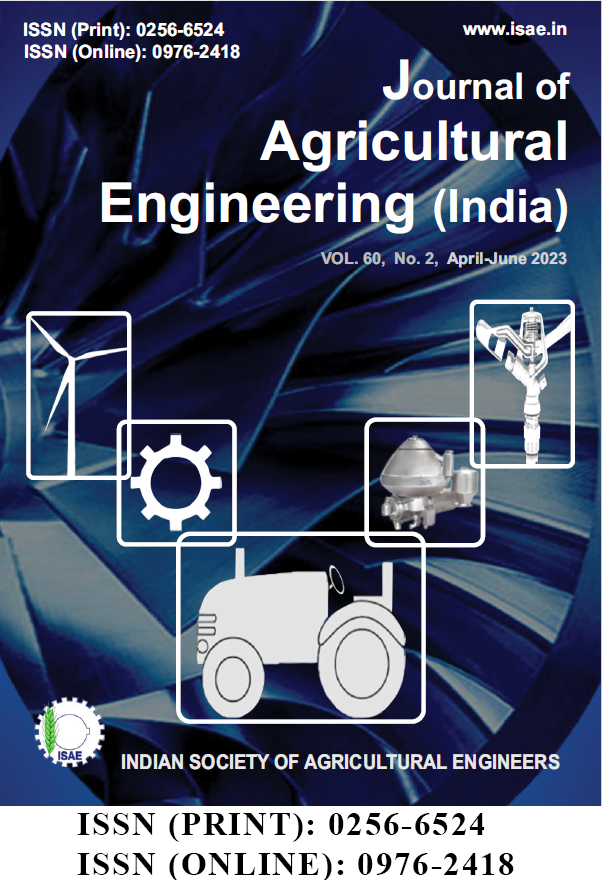An Approach to Analysis of Tractor Workspace Design for Gender Neutral Agricultural Workers
DOI:
https://doi.org/10.52151/jae2023602.1803Keywords:
Anthropometry, constraints, farm mechanisation, Garrett’s ranking method, gender neutral subject, leg force, pedal force sensorAbstract
A survey was conducted using a structured interview schedule gave an insight into the constraints faced in handling farm machinery by female agricultural workers. Workers ranked the pre-determined constraints, which were evaluated using the Garrett’s ranking method. The results indicated that lack of awareness about the machines and their controls together with a lack of training and extension services demoralises the female workers from rendering their contribution to farm mechanisation. Financial dependence, gender gap, difficulty in operating machines, and exclusion from power and decision making in agricultural activities were ranked second, third, fourth, and fifth, respectively, by the female workers. Female workers were also concerned about their technical knowhow of the machines for undertaking frequent troubleshooting and maintenance requirements. The comparison made on the anthropometric data showed that out of the twenty-six anthropometric parameters involved only ten parameters had higher values for female workers than that of the male workers. The average statures of male and female workers were 1744.0 mm and 1568.0 mm, respectively. Some of the operating parameters were analysed to check the existing controls and their priorities in exerting the force required to operate the agricultural machinery. The force required for operation of the controls were significantly high and difficult to operate by the female workers. Hence, female-friendly designs based on Indian female anthropometric measurements are required for farm machines and tractors.
References
ADRI. 2014. Women form half of agriculture workforce in state. https://timesofindia.indiatimes.com
Arya K T; James S P. 2020. Prospects and constraints in mechanization of homestead system of cultivation in Kerala. Agric. Eng. Today, 44(1), 8-11.
Dhanavandan S. 2016. Application x1 Garrett ranking technique: Practical approach. Int. J. Lib. Inf. Stud., 6(3), 135-140.
Doss C. 2011. The Role of Women in Agriculture. Agricultural Development Economic Division, The Food and Agriculture Organisation of the United Nation, Rome, ESA Working Paper 11, pp: 48. http://www.fao.org/economic/esa
FAO. 2017. Productivity and Efficiency Measurement in Agriculture. Literature Review and Gap Analysis. he Food and Agriculture Organisation of the United Nation, Rome, pp: 77. https://www.fao.org/3/ca6428en/ca6428en.pdf
Gite L P; Majumdar J; Mehta C R; Khadatkar A (Eds.). 2009. Anthropometric and Strength Data of Indian Agricultural Workers for Farm Equipment Design. Central Institute of Agricultural Engineering, Bhopal, second edition, pp:253. ISBN No. 978-81- 909305-0-5
Gite L P; Agarwal K N; Mehta C R; Potdar R R; Narwariya B S. 2020. Handbook of Ergonomical Design of Agricultural Tools, Equipment and Workplaces. Jain Brothers, New Delhi, India, pp: 220.
IHD. 2014. India Labour and Employment Report 2014: Workers in the Era of Globalisation. Institute for Human Development, New Delhi, published by Academic Foundation, New Delhi. ISBN: 13: 97893327008. http://www.ihdindia.org Viewed on 13 May, 2022.
MKSP. 2016. MKSP_Agriculture_Guidelines. Mahila Kisan Shaktikaran Pariyojana, National Rural Livelihood Mission, Ministry of Rural Development, Govt. off India, New Delhi, pp: 220. http://mksp.gov.in
Mehta C R; Tiwari P S; Rokade S; Pandey M M; Gite L P; Yadav S B. 2007. Leg strength of Indian operators in the operation of tractor pedals. Ind. Ergo.,37, 283-289.
Mehta C R; Chandel N S; Senthilkumar T. 2014. Status, challenges and strategies for farm mechanization in India. Agric. Mech. Asia Afri. Latin Am., 45(4), 43-50.
OXFAM. 2018. Fighting inequality to beat poverty. OXFAM International, https://www.oxfam.org/en/take-action/campaigns/fight-inequality-beat-poverty , Viewed on 27 November, 2020.
PIB. 2019. Women farmers in the country. Press Infomation Bureau, New Delhi. https://pib.gov.in/PressReleaseIframePage.aspx?PRID=1780263
Potdar R R; Mehta C R; Gite L P; Agarwal K N; Gaikwad B B; Shukla P. 2022. Reach envelope for Indian tractor operators based on anthropometry with a gender neutral perspective. J. Agric. Eng., 59(2), 113-125.
Shukla S; Yadav R. 2017. Compatability analysis of arrangement for some Indian tractors. J. Agric. Eng., 54(4), 16-27.
Singh R S; Singh S; Singh S P. 2015. Farm power and machinery availability on Indian farms. Agric. Eng. Today, 39(1), 45-56.
Theis S; Sultana N; Krupnik T J. 2018. Overcoming gender gaps in rural mechanization: Lessons from reaper- harvester service provisions in Bangladesh. Gender, Climate Change and Nutrition Integration Initiative (GCAN) Policy Note 8. The Cereal Systems Initiative for South Asia (CSISA) Research Note 9. International Food Policy Research Institute, Washington DC, pp: 6. http://ebrary.ifpri.org/cdm/ref/collection/p15738coll2/id/132358.
Tiwari P S; Singh K K; Sahni R K; Kumar V. 2019. Farm mechanization- trends and policy for its promotion in India. Indian J. Agric. Sci., 89(10), 1555-1562.
Victor V M; Nath S; Verma A. 2002. Anthropometric survey of Indian farm workers to approach ergonomics in agricultural machinery design. Appl. Ergon., 33, 579-581.
Yadav R; Kaur N; Gite L P; Randhawa J. 2000. An anthropometry of Indian female agricultural workers. Agric. Mech. Asia Afri. Latin Am., 31(3), 56-60.
Yadav R; Tewari V K; Prasad N. 2000. Tractor workplace design: An application of biomechanical and engineering anthropometry. Agric. Mech. Asia Afri. Latin Am., 31(3), 69-74.














